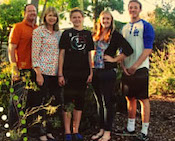Team HIPEC: Expanding Use of Heated Intraperitoneal Chemoperfusion
November 16, 2017 | Lindsay Morgan
Hope where hope used to be scarce
When cancer begins to spread, survival rates decrease rapidly. One of the most common sites of metastasis for gastrointestinal cancers is the peritoneum—the lining of the abdomen. There are approximately 55,000 new cases of peritoneal metastasis annually in the United States. Patients with peritoneal metastasis have an uncertain, but often grim, prognosis.
Over the last several decades, heated intraperitoneal chemoperfusion (HIPEC) has offered new hope. In the HIPEC procedure, following surgical removal of all visible tumors (called cytoreduction), heated chemotherapy is circulated throughout the abdomen to kill any remaining cancer cells. Unlike systemic chemotherapy delivery, which circulates throughout the body, HIPEC delivers chemotherapy directly to the affected area, decreasing toxic effects on the rest of the body.
HIPEC was first used to treat metastasis of appendix and colon cancers, and is now used in mesothelioma, as well as in ovarian and gastric cancers.
The evidence strongly suggests that for selected patients, cytoreductive surgery and HIPEC works. The combination has been shown to reduce the recurrence, in some cases dramatically, of mesothelioma, appendix, and colon cancer, and lead to improved outcomes versus treatment with systemic chemotherapy alone (Esquivel 2016; Chua TC, Moran BJ, Sugarbaker PH, et al. 2012; Franko J, Ibrahim Z, Gusani NJ, et al. 2010; Yan TD, Deraco M, Baratti D, et al. 2009).
HIPEC at UC San Diego
UC San Diego surgeons have been performing HIPEC on select cancer patients since 2007, when Dr. Andrew Lowy joined the Department of Surgery from the University of Cincinnati . Lowy is recognized worldwide for investigating novel cancer treatments. At Cincinnati, he pioneered development of their HIPEC program and demonstrated it could be done as safely as other complex abdominal cancer operations. As the chief of the division of surgical oncology, he launched UC San Diego’s HIPEC program, expanding it substantially with the recruitment of HIPEC experts Drs. Joel Baumgarter, Kaitlyn Kelly, and Jula Veerapong.
Today, UC San Diego is one of only 10 high-volume HIPEC centers in the United States and the only one in the Western United States, having recently performed its 500th procedure (high-volume centers are defined as those performing between 5-10 HIPEC procedures per month). Patient outcomes are generally excellent, and complications are low—likely owing to a team of surgeons with more than 38 years of experience between them.
| UC San Diego HIPECs performed -- by procedure | ||
|
||
| Complication | UC San Diego | Average published outcomes |
| Mortality (within 60 days of surgery) | 0.7% | 1-3% |
| Any complication | 61.3% | 33-60% |
| Severe complication | 15.4% | 25-30% |
| Return to OR | 3.4% | 5-11% |
| Bowel leak | 2.5% | 3-9% |
| Abscess | 6.6% | 4-10% |
| Wound infection | 7.0% | 9-20% |
| Blood clot | 2.1% | 3-5% |
| Ileus (delayed gastric function) of more than 7 days | 15.9% | 5-8% |
| Creation of colostomy or ileostomy | 4% | 14-37% |
| Readmission (within 60 days of surgery) | 16.2% | 14-17% |
The HIPEC A-Team
Each member of the HIPEC team brings unique clinical experience and research interests to the expanding enterprise.
 Assistant Professor of Surgery Dr. Joel Baumgartner, who completed a surgical oncology fellowship at the University of Pittsburgh—the highest volume HIPEC center in the U.S.—arrived at UC San Diego in 2012, and has since built a significant peritoneal mesothelioma practice. He also created a cloud-based database of all UC San Diego HIPEC patients, which, with its wealth of patient data, is enabling numerous research projects. (For example, the database was used in a study to determine predictors of postoperative complications after HIPEC .) Efforts are now underway to explore linking similar databases among other high-volume HIPEC centers.
Assistant Professor of Surgery Dr. Joel Baumgartner, who completed a surgical oncology fellowship at the University of Pittsburgh—the highest volume HIPEC center in the U.S.—arrived at UC San Diego in 2012, and has since built a significant peritoneal mesothelioma practice. He also created a cloud-based database of all UC San Diego HIPEC patients, which, with its wealth of patient data, is enabling numerous research projects. (For example, the database was used in a study to determine predictors of postoperative complications after HIPEC .) Efforts are now underway to explore linking similar databases among other high-volume HIPEC centers.
In another research project, Dr. Baumgartner and Dr. Razelle Kurzrock of UC San Diego’s Center for Personalized Cancer Therapy, are exploring ways to predict cancer recurrence after HIPEC. Imaging of peritoneal metastases for operative candidacy and recurrence is imprecise and often underestimates the actual disease burden. Using a novel platform to detect small fragments of DNA in the blood of HIPEC patients, Baumgartner and Kurzrock’s paper, which is currently being reviewed for publication, shows—for the first time—rates of detection and type of ctDNA alterations in patients with peritoneal metastases undergoing surgical resection.
Interestingly, the DNA studies may also have other positive implications. A UC San Diego cancer patient who underwent the ctDNA test discovered a mutation in his DNA. “Because it was identified,” says Baumgartner, “and because there is a drug available to treat it, the patient was able to get treatment and he is doing really well on this treatment despite failing conventional chemotherapy, which was substantially more toxic.”
Dr. Kaitlyn Kelly, Assistant Professor of Surgery, was the next to arrive at UC San Diego in 2013, after completing a fellowship in complex surgical oncology at the Memorial Sloan-Kettering Cancer Center. Kelly pioneered UC San Diego’s laparoscopic HIPEC program . Normally HIPEC involves opening the entire chest cavity all the way down to the public bone—a major operation. Laparoscopic approaches require less need for narcotic pain medication post-operatively, and related faster return of bowel function; shorter stays at the hospital; and a decrease in complications such as infection.
A Minimally-invasive Approach to Cytoreduction and HIPEC for Peritoneal Surface Malignancy
UC San Diego has enrolled 18 patients in a clinical trial of laparoscopic HIPEC. This investigator-initiated protocol will run from 2015 to 2018, and assess outcomes in patients with low-volume disease. So far, results are good—there have been no complications, and UC San Diego has applied for an extension to enroll an additional 27 patients.
 Most recently, Dr. Jula Veerapong, associate professor of clinical surgery, joined the team in August 2017. Dr. Veerapong brings the program a wealth of experienced from St. Louis University, where, following a fellowship in surgical oncology at MD Anderson, he established a Tumor Board and HIPEC program. Veerapong is spearheading an Enhanced Recovery After Surgery (ERAS) program (read a March 2017 review of ERAS ) for HIPEC patients, which will streamline and enhance their care and recovery through protocols for hospital staff and patients to follow during the pre-admission; pre-operative; inter-operative; and post-operative phases
Most recently, Dr. Jula Veerapong, associate professor of clinical surgery, joined the team in August 2017. Dr. Veerapong brings the program a wealth of experienced from St. Louis University, where, following a fellowship in surgical oncology at MD Anderson, he established a Tumor Board and HIPEC program. Veerapong is spearheading an Enhanced Recovery After Surgery (ERAS) program (read a March 2017 review of ERAS ) for HIPEC patients, which will streamline and enhance their care and recovery through protocols for hospital staff and patients to follow during the pre-admission; pre-operative; inter-operative; and post-operative phases
Meanwhile, Dr. Lowy is leading genetic studies to understand the molecular basis of cancers that spread to the peritoneal surfaces in the hopes of developing new treatment approaches. He is also working with scientists at Sanford Burnham Prebys Research Institute and Columbia University to use small peptides that increase the delivery of drugs to peritoneal tumors. This could make HIPEC therapy more effective and useful to a greater number of patients.
 There are a host of other clinical trials just kicking off or on the horizon that have the potential to improve HIPEC for future patients. A trial will soon begin to study patient recovery using a new drug— alvimopan—which will help speed up bowel function after surgery. Trials related to HIPEC for gastric cancer, ovarian cancer, and GIST (gastrointestinal stromal tumors) are being planned.
There are a host of other clinical trials just kicking off or on the horizon that have the potential to improve HIPEC for future patients. A trial will soon begin to study patient recovery using a new drug— alvimopan—which will help speed up bowel function after surgery. Trials related to HIPEC for gastric cancer, ovarian cancer, and GIST (gastrointestinal stromal tumors) are being planned.
Dr. Lowy’s team is also committed to training the next generation of surgical oncologists. Because HIPEC procedures are complex, lengthy, and mostly open operations involving significant anatomy, observing and participating in HIPEC procedures gives residents a chance to hone their general surgery skills and exposure to the cutting edge of cancer therapy. Many general surgery residents have decided to pursue surgical oncology fellowships—including four of the six chief residents in 2015.
Says Lowy: “Our five-year goal is to be able to offer new and better therapies to our patients with peritoneal metastases that result in longer survival, more cures with fewer side effects. If we are treating patients the exact same way in five years, I would consider that a failure.”
 On the Road with Patients
On the Road with Patients
Advances such as HIPEC offer new hope, but the battle against cancer remains daunting. To accompany and support patients on their journey, the Surgical Oncology division developed a Patient Ambassadors program comprised of past HIPEC patients who offer their time to current or prospective patients.
Shirley Tejidor, Regional Therapies Program Manager for the Surgical Oncology division, who worked at Balboa Naval Hospital and Kaiser before joining UC San Diego, says: “It’s a unique program; not a lot of centers offer it. And it helps patients a lot. Often, patients often are hesitant to ask tons of questions to doctors or nurses. With the ambassador program, they can speak to someone who’s been through it. They don’t have to deal with it on their own.”
 Developed by Lori McIntosh, a former patient of Dr. Lowy’s, who is five years out from her HIPEC procedure and doing well, the ambassadors program kicked off in February 2015, and now has 15 ambassadors. Plans are underway to expand the program beyond HIPEC.
Developed by Lori McIntosh, a former patient of Dr. Lowy’s, who is five years out from her HIPEC procedure and doing well, the ambassadors program kicked off in February 2015, and now has 15 ambassadors. Plans are underway to expand the program beyond HIPEC.
Much has been done to improve chances of cure for patients with peritoneal metastasis, and UC San Diego is leading the way—pushing for better, more effective treatments, and creating compassionate support structures for patients and their families. But there is a long way to go.
Says Lowy: “I’m optimistic about the future, and proud to lead a team of surgeons, staff and nurses who are strong willed and soft hearted—pushing the science forward and supporting patients in their journeys.”
